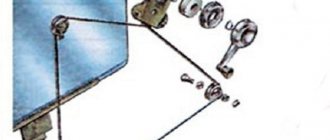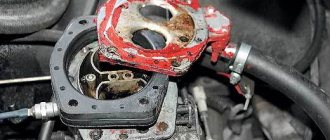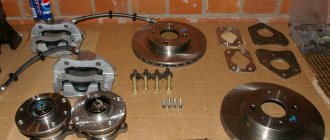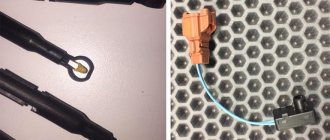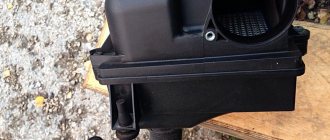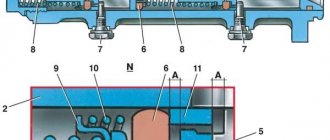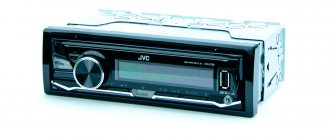Good day to all! If you are here, then you are definitely interested in a surround view system for a car.
It is a mistake to think that now you can only buy a car with factory equipment that includes such equipment. In fact, it is also possible to independently install a system capable of displaying what is happening around the vehicle at 360 degrees.
For the first time, such a development was proposed by Nissan engineers. The Japanese, as an option, equipped their cars with cameras that provided the same all-round visibility. Due to this, the parking system received a new round of development.
Purpose and functions of the all-round view
The all-round visibility system is part of the car's active safety. Its main task is to collect visual information around the car and then display it in the form of a circular panorama on the multimedia screen. This allows the driver to better navigate and fully control the situation around the car in difficult driving conditions or when parking. Thanks to this, the risk of emergency situations is significantly reduced.
If the automatic transmission selector is switched to reverse mode (R), the all-round visibility function is activated automatically. It can also be turned on forcibly using a button.
A similar system was first installed in 2007 on Nissan cars, called AVM, which stands for Around View Monitor . As a rule, the all-round viewing function is present in premium cars. However, now it can be installed in any car by first purchasing a ready-made kit with all sensors and a control unit.
Surround View System
Among the main functions are the following:
- the ability to accurately maneuver in confined spaces or off-road. The driver is shown a picture around the car in great detail, including the most “not visible” sections of the road;
- possibility of motion recording (optional).
How to make an all-round view on any car?
As mentioned above, not all cars can boast of having a standard all-round visibility system, although it provides invaluable assistance to the driver in a wide variety of situations on the road, greatly increasing safety.
What should you do if you want to have such an option in your car?
In fact, there are no problems with this; fortunately, the market offers a sufficient number of different taste and color options for car all-round viewing systems.
Moreover, they often offer even more functionality than the standard ones installed from the factory. So, for example, you can purchase a system that will not only display images from cameras on the screen, but also record video streams, like a regular recorder.
Standard surround-view systems can only be activated at speeds up to 10-15 km/h
Show pictures regardless of the speed of the car (standard ones can usually be activated only at speeds up to 10-15 km/h), superimpose projections of dynamic lines of the trajectory so that you know exactly whether you will fit into the parking space in terms of dimensions, and so on.
Elements and principle of operation of the system
The all-round viewing system includes:
- 4-5 cameras with wide-angle views located on the sides, rear and front of the car;
- sensors that receive signals about obstacles around the car;
- multimedia screen (standard system or installed separately);
- Control block.
Modern all-round viewing systems, purchased separately, can be equipped with a video recorder. The installation of this element can be hidden or standard, which will provide additional protection for the vehicle when parked in unguarded areas.
Location of system components
The work is based on the collection of visual information by sensors (cameras) installed:
- in the rear-view mirrors (right and left, respectively);
- in the radiator grille;
- on the trunk lid or rear door.
Depending on the model and manufacturer of the system, there may be either 4 cameras or 5 video recording devices.
Due to the fact that the cameras provide panoramic shooting, the viewing angle is a full 360°. The viewing modes that are displayed on the multimedia screen are selected by the driver and can be as follows:
- parking – turns on automatically when the gearbox selector is moved to the “R” position (the speed should be no more than 10-20 km/h);
- panoramic – images from all installed video cameras are displayed on the screen simultaneously (top view);
- manual – selected independently by the driver and depends on the desired viewing position in a particular situation.
Installation Features
Objectively, one rear view camera is inferior in functionality and safety to a full-fledged all-round car vision system. Therefore, more and more often, car owners are thinking about re-equipping their car and switching to a more advanced control scheme.
Nowadays, buying a complete set of all-round viewing on Aliexpress or in other stores is not a problem. And the price is quite reasonable. The main thing is that the components are of good enough quality and that the connections are made correctly.
To connect the all-round view, you need to purchase 3 components:
- smart display, that is, a screen with brains;
- at least 4 cameras;
- wiring kit
Plus you will need a standard set of tools, glue, cutting tools, etc.
As for displays, there are several options:
- Selector for cameras. It alternately displays images from different cameras. The driver can choose which camera to activate. But here we don’t have to talk about a full-fledged all-round view;
- Display with the function of simultaneous processing of data from 4 cameras. In this case, video from all cameras is displayed on the screen at once;
- A screen displaying 4 cameras, composing and displaying the car in the form of a 3D panorama. These displays are considered full-fledged all-round viewing systems.
If we talk about cameras, then in front and behind you need regular parking devices. They're pretty cheap. Moreover, it is better to take simple options without unnecessary functions and show-offs. And on the left and right sides we need panoramic cameras with a wide viewing angle.
Advantages and disadvantages
Vehicles equipped with an all-round visibility system have a number of advantages:
- the ability to constantly monitor the situation around the car both while driving on the road and while parking;
- all-round visibility and absence of blind spots, thanks to the panoramic image transmitted by the corresponding cameras;
- the ability to record the resulting video, use the system as a DVR.
Modern cars have received a lot of various auxiliary systems that significantly increase comfort and safety. Additional all-round viewing capabilities of the car allow the driver to easily obtain various information about what is happening around him on the road or while parking, as well as record the resulting image. If previously such systems were only available in expensive cars, today anyone can install them.
How it works
When the system is activated, the display is usually divided into 2 parts. One of them displays a panoramic image, and the second one displays an image from one of the cameras. Mainly from the back.
The factory all-round visibility system is integrated into the parking sensors, with which interaction is carried out. This allows you to display graphics of the direction of movement on the screen, divide zones into red and green, thereby marking the distance to obstacles. Additionally, the driver is notified by sound signals.
It is important to understand that all-round visibility usually works when driving at relatively low speeds. The system is activated either automatically when driving in reverse gear, or manually using switches in the cabin.
Self-installation
First, you will have to buy all the necessary electronics.
Purchases
- First of all, select the “processor” with display.
If you are going to save money, you can buy a selector for four cameras. It will display an image of only one of them. You can select a broadcasting device using the remote control.
You can also purchase a digital video recorder for cars - station wagon. It will display images from four cameras simultaneously on the display.
But the pinnacle of digital thought are expensive but functional video recorders that are capable of editing four images into one panoramic one and at the same time placing an image of a car in the environment so that the driver can control it as if from a third person.
- Next, purchase cameras.
For front and rear installation, regular cameras for cars that have parking lines are suitable. They are not very expensive; it makes no sense to buy “sophisticated” devices for these purposes.
To install on mirrors, you will need special panoramic cameras. They don't need parking lines. All that matters is a large viewing angle. They will cost a little more.
How to equip the car
Previously, it was impossible to imagine that someone could independently assemble and install such a complex system in a car. It was assumed that it could only be built into the car’s factory equipment and nothing else.
However, everything is changing and today any car enthusiast whose hands grow from the right place can equip their “iron horse” with such a device.
With the help of specialists
In order to equip your car with an all-round visibility system, you can come to a service station that provides the relevant services and contact specialists. This is a reliable option, the only downside of which is the need to pay for the work of the craftsmen.
But the installation of an all-round viewing system can easily be done by the car owner.
Installation recommendations
When everything necessary to install the all-round viewing system has been purchased and assembled, you can begin to work.
- At the first stage, you should determine all the places where the cameras will be located.
- It is recommended to install the rear camera first. You may need to cut a hole for it on the platform intended for fixing the license plate.
- After cutting, sand the area using sandpaper.
- The easiest way to fix the camera itself is with glue that is resistant to weathering and temperature changes.
- Then the front parking camera is mounted in the radiator grille area. For installation, the same principle applies as with the rear camera.
- Then comes the turn of the side cameras. They are mounted in mirrors, and this procedure causes much more difficulties. The mirrors themselves are first dismantled, a hole is made in the body for the camera and fixed in it.
- Using door connectors, the wiring is pulled into the interior. After this, the side mirrors return to their place.
- The wiring from the rear and front cameras also needs to be routed through the interior. Here you should act based on the design features of a particular car, existing technological holes, etc. You will probably have to remove the trunk trim. In the cabin, it is better to stretch along the floor than along the ceiling. It is important that during operation the driver or passenger does not touch the wires and cannot accidentally damage them.
- At the final stage, when the wires are connected to the monitor, the setup is performed. The setup procedure is carried out strictly according to the instructions from the display manufacturer.
Most ready-made kits for all-round viewing provide detailed instructions for connecting, installing and configuring the system.
How to install a surround view system
If the installation of such a system is not provided by the manufacturer as an option when purchasing a car, the driver can install it independently or with the help of service center specialists. You can find ready-made installation kits on sale, but, if you wish, you can purchase elements separately from each other to save money. To implement a surround view system in a car you will need:
- The display is the brain of the system. There are three options for such devices on sale:
- A selector for four cameras that can display images from them in turn. That is, the driver will be able to choose which camera he wants to see the image from at the moment, and then switch to it. In fact, this option cannot be called a full-fledged all-round viewing system;
A display with a “brain” that can simultaneously process signals from four cameras. This means that the driver will see video from four cameras on the screen at once, thereby completely controlling the situation around the car;- A display with a “brain” capable of displaying information from four cameras, composing it and displaying a 3D panoramic view of the car from above or from a third person (depending on functionality). Such displays allow you to implement a full-fledged system of all-round visibility of the car.
- Four cameras. The important thing to note here is that cameras should be different. You will need to install regular parking cameras in front and behind the car, which allow you to display the appropriate parking lines. Their cost is low, and it is better to purchase budget models without additional bells and whistles. Panoramic cameras should be installed on the left and right mirrors, which do not have parking lines, but have a large viewing angle.
- Standard tools and consumables for such work: glue, wires, cutting tools, etc.
When all the necessary equipment and tools have been purchased, you can proceed to the process of installing the all-round viewing system. It looks like this:
- First of all, we install the rear camera on the car. To do this, cut a small hole in the center of the platform for attaching the license plate. Next, be sure to sand the surface. Install the camera and secure it with glue. Please note that for work you need to choose an adhesive that does not change its properties at different temperatures;
- Next, a second camera is installed in the radiator grille at the front of the car using the same principle;
- The next step is to install cameras in the mirrors. This procedure is somewhat more complicated than installing front and rear cameras. To install the camera in the side rearview mirror, you will first need to remove it. Next, carefully make holes in the mirror frame for attaching cameras and secure them inside. Pull the cables that come from the cameras through the door connectors and install the mirror back on the car. This must be done with both side mirrors;
- After this, you will need to run wires from all cameras to the “brain” of the system and the display;
- The final step is setting up the system. Depending on which monitor model you choose, as well as the processor installed inside, the instructions for setting up the system will vary. Please read the instructions included with the device to ensure correct setup.
Having completed the steps described above, the installation of the car's all-round visibility system can be considered complete. After this, you will be able to see what is happening around the car when parking, thereby minimizing the risk of damage to the body due to unsuccessful maneuvering.
( 400 votes, average: 4.57 out of 5)
Windshield washer nozzles: replacement, cleaning, selection
Pros and cons of welding disks
Related Posts
In what situations is such equipment useful?
One gets the impression that such equipment can only be used for parking. However, it is not. The range of applications of such devices is much wider and is not limited to parking alone. So, cameras will also help in the following situations:
- When driving through blind intersections. Often, a camera mounted at the level of a car's radiator grill will be able to see much more than the driver. It is capable of ensuring safe passage through intersections with blind spots.
- When driving on narrow streets. Often the driver has to stretch out to his full height and look to see if his car is hitting obstacles in the form of cinder blocks, curbs, parking posts or other cars. This system makes driving in narrow areas easier.
- Orientation on the road. Some novice drivers are so superficially familiar with the dimensions of their car that they do not know how to pass a hole or other obstacle between the wheels. Often they don't even realize how far they are from other cars or medians. The all-round visibility system will make life much easier for amateur drivers.

